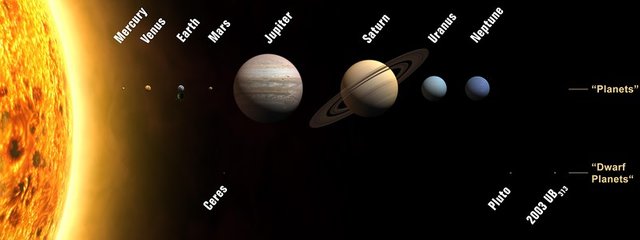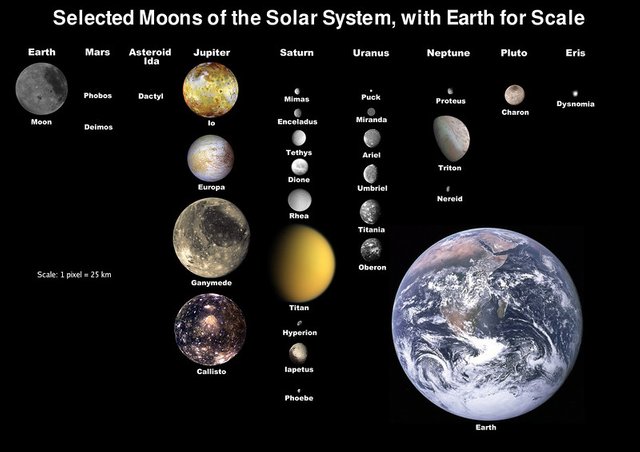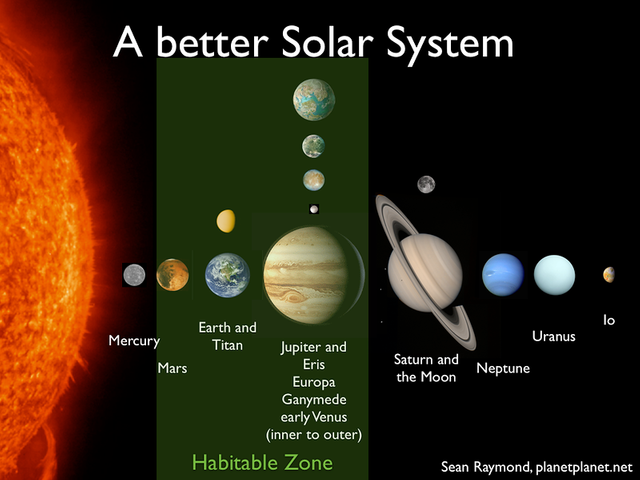Playing God and building a better Solar System
Sean Raymond, astrophysicist from Laboratoire d'Astrophysique de Bordeaux, studies formation and orbital evolution of planets both in the Solar System and extra-solar planetary systems.
He offers to try a thought experiment - how to maximize the number of habitable worlds in our system.
Existing Solar System is far from optimal from the point of view of comfortable conditions for life. We have only one inhabited planet with forests , oceans, blue skies, beer and Steemit. There are several potentially inhabited worlds, but they are located in wrong places. Jupiter's moons Europa and Ganymede have plenty of liquid water but it is hidden beneath miles of ice, and Europa is in the high radiation zone. Saturn's moon Titan has rich atmosphere and hydrosphere, but they are made of liquid hydrocarbons. Mars was beautiful long ago but now it's a cold and dry desert.
Raymond offers a God's game - how to rearrange worlds of the Solar System to get multiple habitable worlds. He includes here not just planets.
Some of the best candidates for life might actually be large moons or what we now call minor planets; these are objects like Pluto that are a little too puny to be called planet.
The rules are simple:
We can pick planets, moons and minor planets only from available stock.
We keep the Solar System’s orbits, both of planets and minor planets around the Sun, and of moons around planets. We can’t just add orbits where we want, but we can swap them
Here is our start set:

Image: Kerbal Space Program - a planets
And interesting moons

Image: NASA - Earth added for scale
Which bodies have the potential for life? This is difficult question because we don't know the exact conditions that are needed to make planet habitable.
So let's simplify. We need liquid water, a source of heat and proper amount of heat. This means that our worlds should orbit the Sun in the liquid water habitable zone which stretched from 0.9 to 1.6 a.u. (1 a.u. = 150 million km=Sun-Earth distance). And planets with crazy orbital tilts or very thick atmospheres might be habitable a little farther out.
The best candidates are:
Earth (we know this)
Venus - terrible place at the place where it is located now. Too hot and dry. Need to enrich it with water from asteroids and comets.
Mars - Mars may have been habitable in the distant past, and it is possible that its surface could remain habitable for billions of years under different conditions
Moons of the gas giants - rocks and water, only heat is needed.
The dwarf planets, especially the largest ones: Pluto, Eris, Sedna, Haumea, Makemake, etc..
Like the large moons, these minor planets are thought to be made mostly of rock and water ice and so should make nice little water worlds. However, their low gravity could make it hard to retain an atmosphere for billions of years in warmer conditions
Let's put as many potentially habitable worlds into a habitable zone. We put Jupiter on the outer edge of habitable zone - on the Mars orbit and replace the Earth's Moon with better candidate for life. So, here is the rearranged, better Solar System:

Image: Sean Raymonds
This Solar System could have seven habitable worlds instead of just one. Imagine all the interplanetary or inter-moon disputes, vacation destinations (little ocean worlds!), and alien encounters you could have in my new, better Solar System! Much more interesting and full of life than the real Solar System!
Source: https://planetplanet.net/2013/06/11/build-a-better-solar-system/
So a Job as a, Solar Architect,
doesn't involve messing about with large Panels.
A Masters Degree in Galaxy Rearrangements,
now that sounds more like someone working on the next
Beyoncé Family Pool Party.
But I like your thinking.